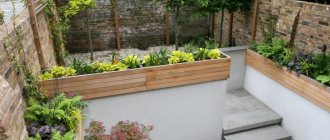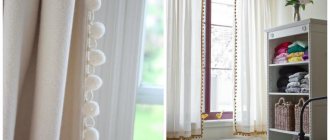Indoor plants in the interior make the room more comfortable; with their help, you can create a stylish modern interior. They improve the microclimate of the home, moisturize and purify the air, and absorb harmful vapors and carbon dioxide.
The choice of plants depends entirely on your taste. But, knowing certain recommendations for placing and caring for them, you will ensure that representatives of the evergreen flora of the subtropics and tropics will delight with lush greenery, and African and South American beauties with gorgeous flowers.
It is possible to create ideal conditions for plants as much as possible only in a greenhouse with a sufficient number of large, high windows, maintaining the temperature balance and maintaining the necessary humidity.
But different plants may require different comfortable conditions depending on light, heat-loving and humidity conditions.
Basic recommendations for placing indoor plants in the interior:
- place plants as far as possible from radiators;
- do not create strong drafts (especially in winter), but ventilate the premises;
- Place plants near windows depending on the brightness of the light.
In addition, do not forget that plants are living organisms that need care. Timely watering, fertilizing, loosening the soil, wiping (and possibly washing) the leaves from dust require an accessible location of the plants.
Large flowers can be placed on low floor stands. Climbing ones require placement on vertical supports, walls or suspended on windows.
Flower stands: let's imagine without borders
The window sill space is limited by the length, width and height of the window. On large window sills you can create a full-fledged flower garden. With the standard one you have to get out of the situation:
- a flower rack is a great way to place more than one flower on the windowsill;
- forged stand - a practical and stylish solution;
- a DIY ladder opens up space for ideas;
- shelves made of various materials expand the possibilities of small window sills;
- Even a low flower spacer can accommodate up to a dozen flower pots.
Features of growing perennial everflowering plants
Ever-flowering plants will help fill your apartment with bright colors. Their cultivation has some specifics:
- unlike most flowers, they do not have a dormant period at all or it is not clearly expressed;
- flowering requires a lot of effort, so such plants should be fed more often;
- once a year, evergreens must be transplanted into a larger pot or transferred to the same one, changing the soil;
- During the flowering period, it is important not to forget about watering, otherwise the plant may drop its buds.
Interesting! Psychologists believe that having plants in your home that bloom during the cold season is very beneficial for mental health. They serve to prevent depression.
Otherwise, caring for ever-flowering plants is no different. It is important to observe the temperature regime, water, fertilize and replant flowers on time.
There are many unpretentious plants that are ready to delight with luxurious flowers all year round. Everyone will be able to find something to their liking and turn their home into a real magical garden.
5 / 5 ( 1 voice )
Reliability and convenience: zoning the space
A regular shelf for flowers on a window sill made of wood or plastic is the optimal solution when you need to make the most of the available space. Depending on the height of the window and the types of flowers, two or three flower shelves are installed.
Convenient spacers. They are usually used for low plants - the result is a potted tree. They are often used to place indoor violets - Saintpaulia.
When placing indoor flowers on the windowsill, do not forget that the window light should sufficiently penetrate the room.
Metal products should be securely fastened so that metal structures do not collapse and break the window.
Indoor flowers for children
If there are small children at home, safety comes to the fore, because kids experience the world tactilely, by smell and taste. We have chosen several plants that will be completely harmless to your precious child!
Lemon Tree
Lemon is light, fresh and clean, and its leaves contain beneficial essential oils. It has a pronounced antibacterial effect, and also a subtle pleasant aroma.
Violet
Unpretentious violets create a feeling of warmth and comfort in the room, which is so valuable for children. Flowers and leaves are completely safe, because sometimes the petals are even used to decorate dishes in cooking.
Tradescantia
The flower is not only unpretentious, but also completely harmless, even if a child tastes it. Bright two-color leaves decorate the interior and delight with interesting colors.
Cypress
Children are attracted to the whimsical cypress tree by its unusual shape and texture. It has natural antiseptic properties, so it destroys bacteria and fungi around it.
Peperomia
Peperomia leaves contain healing phytoncides that improve the health of the air. This is a good choice if your child is often sick and you need to strengthen his immunity.
Decembrist
For many years, an ornamental plant with unusual segmented shoots and leaves has been found in apartments. Children are attracted by the bizarre shape and bright, colorful blooms.
Charming violets: growing flowers on a windowsill
Saintpaulia is a favorite among indoor flowers. These are the best friends of flower growers, amazing with the variety of varieties and the beauty of the inflorescences. A staircase design is perfect for them:
- easy to distribute plants by variety;
- free access is provided for watering and caring for leaves;
- each flower receives enough light.
An excellent option is spacer structures. You will get a small “tree” of Saintpaulia that your family will love and your guests will definitely notice.
The most unpretentious indoor flowers
A green corner does not necessarily mean a lot of new troubles and a waste of time. There are many completely unpretentious flowers that require your minimal participation.
Ficus
At the head of unpretentious and universal plants for the home is unconditionally the ficus with all the variety of its varieties. There are compact species up to 20 cm, and there are full-fledged trees that stretch several meters.
Aspidistra
Aspidistra became a regular guest in offices precisely because of her unpretentiousness. For decorative leaves, weekly watering is enough so that the temperature around does not fluctuate more than 3-5 degrees.
Aloe
Healing aloe is widely used in pharmaceuticals, cosmetology and hundreds of folk recipes. It is infinitely unpretentious on the windowsill, because the fleshy leaves independently store moisture and nutrients.
Aglaonema
Aglaonema is afraid of direct sunlight, so it is ideal for remote and shady corners. Decorative variegated species differ in color, up to rare red-pink.
Fuchsia
Beautiful decorative fuchsia can be easily grown at home on a windowsill, especially since in winter it just likes cool weather. In summer, the flower can be taken to the country and transplanted into a container.
Asparagus
Beautiful and unusual asparagus with needle-like leaves requires periodic watering and annual replanting. Otherwise, it does not need any special conditions and any lighting is suitable.
Balsam
Although impatiens are called impatiens, the small bush is completely unpretentious to care for. Partial shade and plenty of watering are enough for him, but he is completely indifferent to dry air.
Flowers on the windowsill in pots: is everything ingenious simple?
There is often a great temptation to simply arrange flowers in a row. This decision has arguments for and against, since not all flower arrangements turn out harmonious and decorate the room. The following rules should be followed:
- a row of plants planted in identical pots, ceramic or glass, but not plastic, looks stylish;
- You shouldn’t put your grandmother’s favorite aloe and a trendy orchid next to each other;
- the flower extravaganza of indoor roses is unlikely to tolerate the proximity of begonias - they are too different and will not complement each other, just as tall plants are uncomfortable among small Saintpaulias;
- Pots decorated with craft paper are good - this is an excellent option to hide the simplicity of a plastic container.
Even the most ordinary pot will be beautiful and appropriate if a well-groomed flower grows in it and pleases the eye. And a truly original idea is born when the work we are doing is loved and brings great joy of creation. Therefore, you will definitely find your own version of arranging indoor flowers.
technology project on the topic “Indoor plants in the kitchen interior”
Municipal educational institution secondary school in the village of Record, Krasnokutsky district, Saratov region
Creative project on technology
"Indoor plants in the kitchen interior"
Completed by 7th grade student Irbicheva A
Technology teacher Gvozdyuk T.G.
year 2013
- Description of the kitchen.
- Kitchen area sq.m. The window faces southwest. The window is large and has a fairly wide sill. The kitchen is bright. A window and a set are suitable for placing indoor plants in such a room.
- Kitchen plan.
- Choosing plants for kitchen landscaping.
The kitchen is one of the most comfortable places for houseplants. It is always ventilated, it is always warm here, and the flowers are at hand, so they do not suffer from lack of care.
The kitchen is the busiest place in the house, where many people are constantly present. Therefore, pots and tubs with plants should not interfere with their free movement. For the same reason, you should not place a large number of pots or large floral arrangements in the kitchen. The best place for flowers is a surface right under the ceiling, the top of the refrigerator, window sills, a tabletop along the wall, and bedside tables. In addition, small pots of climbing or creeping flowers can be hung on the wall or placed in or near a window like in our kitchen.
. In general, it is not advisable to fill the entire kitchen with flowers. Thoughtful phytodesign looks much more interesting, especially if its elements visually increase or decrease the space. Thus, a basket with hanging plants “lowers” high ceilings, and a floor pot with a tree “pulls” them out. Small leaves and arched stems will expand the narrow space
What indoor plants and flowers are suitable for the kitchen? Unpretentious, not too expensive plants are suitable for the kitchen. Cacti, ferns, monstera, geranium, aspidistra, hibiscus, passionflower, pendulous begonia, and sansevieria take root well in the kitchen. Citrus trees - tangerines, lemons, kumquats - would be very appropriate.
Of course, the kitchen cannot do without fresh, healthy herbs, which are so lacking in the winter - basil, dill, onions, parsley, mint, lemon balm, marjoram, mustard, cilantro.
So for our kitchen we chose Kalanchoe, indoor rose, geranium, Decembrist. They were placed on the windowsill. The window faces south; these plants require good lighting. When placed on a windowsill, plants should be low so as not to shade the room. Fern and money tree were placed on the table set. Philodendron and cissus hung opposite the window.
4.Description of indoor plants.
Kalanchoe - K. Blossfeld Grows in tropical rainforests on humus soil on the island of Madagascar. Subshrubs, few branches, erect, up to 30 cm tall. The leaves are ovate, up to 7 cm long and 4 cm wide, glabrous, green, reddish at the edges. The flowers are numerous, collected in umbrella-shaped inflorescences. It blooms profusely and for a long time, in February-May (it can bloom at other times of the year). Most plants are removed after flowering, but they can be preserved until the next season - cut off the flower stalks, place the pot on a shady windowsill, hardly water it for a month, and then move it to a well-lit place and care for it as usual.
Pelargonium. In common parlance, pelargonium is called indoor geranium. The plants are unpretentious and easily propagated by stem cuttings; Pelargoniums are easy to care for. With good lighting, they are able to bloom with large fragrant flowers almost all year round.
Zygocactus truncated is colloquially called “Decembrist”, hinting at its flowering time. Homeland - tropical rainforests of Brazil.
To re-bloom next year, a dormant period is required, during which watering is reduced and the temperature is lowered. Fresh air has a beneficial effect on the well-being of the cactus.
Fern - the temperature should not be higher than 22-250. the lighting should not be too bright, and the earthen clod should not be allowed to dry out.
Crassula - Crassula (Crassula Arborescens) - the most common species, better known as the “Money Tree” or “Tree of Happiness”. At home, in South and South-West Africa, its height can reach 3 m. In cultivation, it is a small tree about 1.5 m tall, with fleshy, round, shiny leaves. Location: Crassulas need bright light, even during winter dormancy. Do not require shading from direct sunlight. They grow well on south and south-east windows. With a lack of light, the stems become thinner, elongated, and the leaves on them become smaller. In summer, the plant does well outdoors.
Temperature: the optimal temperature for the Crassula in the spring-summer period is 22-25°C; in winter they are kept in cooler conditions at 12-15°C, but not lower than 5-7°C. Avoid high winter temperatures, otherwise the plant will become lanky and the leaves will fall off.
Watering: Crassula (crassula) must be watered 1-2 times a week from spring to mid-autumn, allowing the top layer of the substrate to dry between waterings, then 1-2 times a month with soft water. At temperatures below 12°C, do not water at all.
Air humidity: air humidity does not play a significant role; Crassulas normally tolerate dry air in apartments. But they need fresh air - in the summer the room should be ventilated. Sometimes it is necessary to wipe the leaves with a damp cloth so that the plant does not become dusty and does not lose its attractiveness.
Philodendron. Homeland Central and South America. The lighting required is not too bright. The plant needs diffused light or partial shade. The soil must be kept moist at all times. In winter, watering is reduced. Air humidity is high.
Cissus - Evergreen climbing shrubs with flexible stems. Very hardy plants and perfect for indoor conditions. Propagated in spring by cuttings taken from last year's shoots. Root at a temperature of about 20 degrees under glass for 2-3 weeks. Planted in loose humus soil. Operates at a temperature of 14-16 degrees. Watering in summer is plentiful, in winter it is moderate, although in warm rooms with central heating it is necessary to water almost daily in winter. Adult plants are replanted every two to three years. Cissus - Cissus family of grapes. Number: about 350 species. Place of origin: tropics and subtropics.
Roses are the secret to the success of their cultivation in the house - intensive watering, plenty of air, bright light and high humidity. In winter, it is recommended to keep pots with plants on sunny windows, and in spring take them out into the fresh air.
Planting.
Our plants are planted in plastic pots because they look good and are inexpensive. But since the walls of plastic pots do not allow moisture to pass through and it is difficult to regulate the watering of plants in them, looser soil is needed. We use “Universal” soil soil, as it is suitable for many plants, and soil for succulents (zygocactus, crassula). Expanded clay was poured onto the bottom of the pots for drainage.
My advice.
- Flowers can be planted in pots in the form of a teapot, saucepan, tea cup, some fruit or vegetable. You can make flower pots with your own hands.
Sources used.
- Internet resources. Brief description of plants.
- Magazine "Flower" No. 6 March 2008











